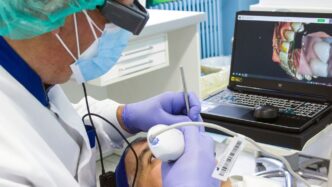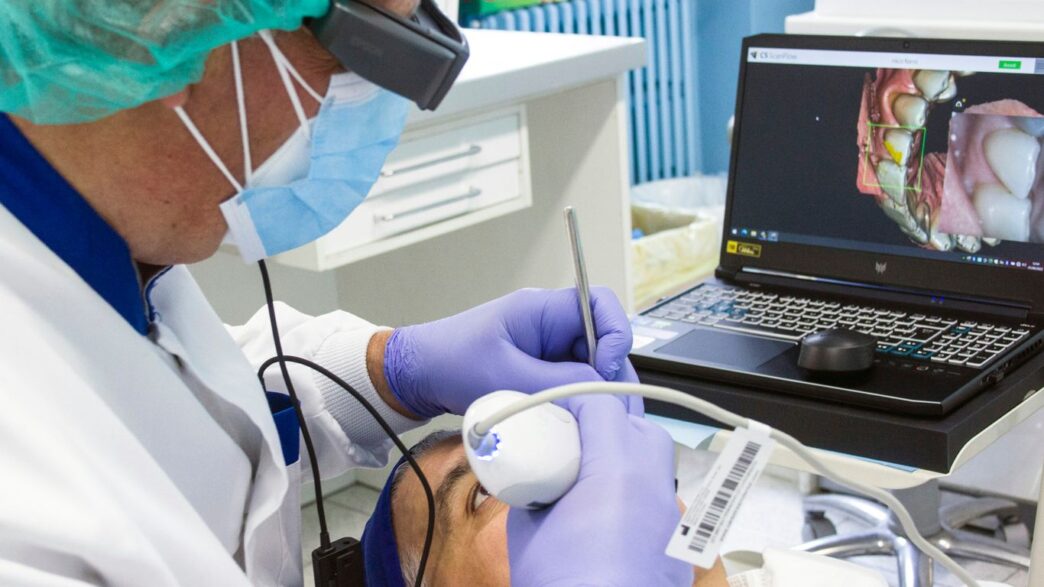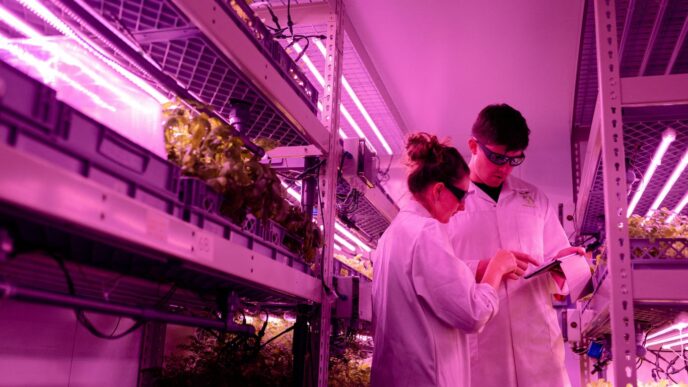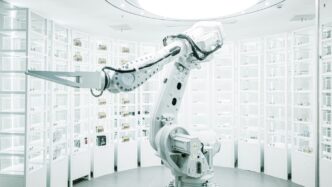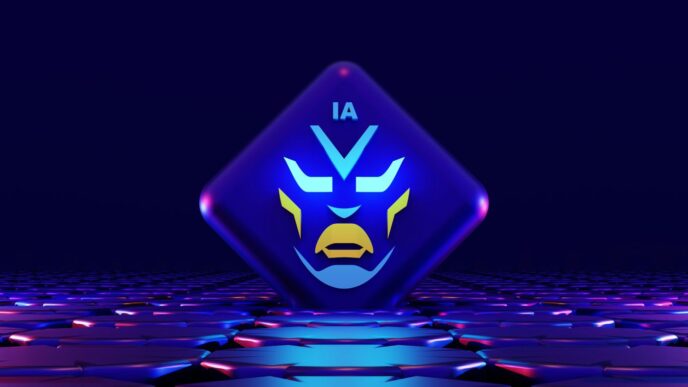AI in cancer diagnostics is changing the way doctors find and treat cancer. It’s not just about fancy machines—it’s about using smart computer programs to spot cancer earlier, help doctors make sense of scans, and even suggest the best treatments for each person. These tools are popping up in hospitals big and small, making care better and sometimes faster. But there’s still a lot to figure out, like making sure everyone gets the same quality of care and that the technology works for all kinds of people. Here’s what you should know about how AI is making a difference in cancer diagnostics.
Key Takeaways
- AI in cancer diagnostics helps doctors spot cancer earlier, even in places with fewer medical resources.
- Smart computer programs can look at scans and images to find tumors that might be missed by the human eye.
- AI tools can sort through genetic information to help pick the right treatment for each patient.
- These systems are also being used to reduce gaps in care for people in rural or minority communities.
- There are still challenges, like making sure AI is fair, accurate, and easy to use in real-world clinics.
Transforming Early Detection Through AI-Powered Screening
The way we spot cancer early is changing fast, thanks to smart AI tools that can screen and triage patients with speed. AI-powered screening holds the promise of catching cancer sooner, especially for people who might not have access to clinics or specialists. Here’s a closer look at how this is unfolding.
Expanding Access to Cancer Screening in Underserved Areas
Access to regular cancer screening is still a big challenge in rural towns and underserved neighborhoods.
- AI-driven mobile units can bring screening to people where they live, avoiding long trips to major hospitals.
- Telepathology platforms let experts review tissue samples from afar, even when local pathologists aren’t available.
- Data models use information from electronic health records to pinpoint areas at greater risk and guide outreach.
| Area Type | Traditional Screening Access | AI-Powered Screening Impact |
|---|---|---|
| Urban | High | Maintained, faster triage |
| Rural | Low | Significant access improvement |
| Low-income regions | Variable | Increased, especially via mobile |
Reducing Diagnostic Delays Using AI Algorithms
Waiting for a cancer diagnosis can stretch from days to weeks. With AI, the lag time can be much shorter.
- AI tools sort high-risk cases in real time, so specialists see the most urgent biopsies first.
- Automated text analysis highlights suspicious symptoms or historical trends in medical records.
- The faster analysis helps patients begin treatment sooner, possibly leading to better survival odds.
A typical workflow now includes:
- Automated flagging of high-risk scans
- Immediate digital sharing with pathologists
- Rapid generation of preliminary reports
Enhancing Sensitivity and Specificity in Imaging Analysis
Some cancers are tricky to spot, especially in dense tissue or early stages. AI can help by picking up subtle, hard-to-see changes in imaging.
- Deep learning models in mammography or CT scans have outperformed radiologists in certain studies.
- They can reduce false negatives—missed cancers—and cut back on false positives that lead to unnecessary worry or testing.
- AI analysis works consistently across patient types, even when radiologist experience varies.
| Diagnostic Modality | AI Sensitivity | Conventional Sensitivity | Difference |
|---|---|---|---|
| Breast Cancer (Mammo) | 94.5% | 88.3% | +6.2% |
| Dense Breast (AI+Mammo) | 97.4% | 92.1% | +5.3% |
AI’s progress isn’t just technical; it’s making early detection possible for more people, more quickly, with fewer mistakes.
Advancements in Medical Imaging With AI in Cancer Diagnostics
Deep Learning Models for Tumor Identification
It’s wild how far AI has taken us in spotting tumors. Deep learning models, trained on thousands—sometimes millions—of cancer images, can pick up the tiniest signs of trouble way faster than a person staring at scans all day. Sometimes, they spot subtle changes a human might miss entirely. These models are now finding tumors in things like CT or MRI scans with such accuracy that it’s almost like having an extra expert on call for every patient.
Here’s what these systems do best:
- Recognize suspicious patterns in tissue, even tiny ones
- Compare new scans to tons of previous cases for better judgment
- Cut down on the number of missed cancer cases (those false negatives we all worry about)
Improving Interpretation of Radiology and Pathology Images
Radiologists and pathologists have a tough job—those tiny dots and smudges on an image can mean life or death. AI is now acting like an always-available teammate who never gets tired or distracted. These algorithms look over images like mammograms or digital pathology slides and flag anything off, so actual specialists can focus on the toughest calls instead of slogging through every scan. There’s also evidence that with AI backup, doctors make fewer mistakes, and people get answers faster.
Comparison Table: Human vs. AI in Cancer Imaging
| Imaging Task | AI Sensitivity | Human Accuracy | Risk Reduction (Missed Cancer) |
|---|---|---|---|
| Breast Cancer (Mammography) | 94.5% | 88.3% | 6.2% improvement |
| Dense Breast Tissue Analysis | 97.4% | 92.1% | 5.3% fewer misses |
These numbers show how AI is already providing an edge, especially in the trickiest cases.
Integrating Computer Vision for Risk Assessment
What’s new is that computer vision (which means teaching computers to "see" like we do), isn’t just finding tumors—it’s starting to predict how risky they are. By analyzing things like nodule size, shape, and exact position, these AI tools can sometimes estimate a patient’s risk level right from the scan. That helps both doctors and patients move quicker if something’s up, or breathe easier if it’s not.
A few ways computer vision is changing things:
- Automatically scoring a tumor’s danger, so the serious cases get fast-tracked
- Flagging hard-to-spot features (like tiny nodules that could be early cancer)
- Comparing patient scans to giant image databases for best-match predictions
Honestly, AI’s help in cancer imaging isn’t science fiction anymore—these changes are happening in clinics right now. The real challenge now is getting these tools to more places, so more people benefit, not just big hospitals with deep pockets.
Personalizing Cancer Care Through AI-Driven Precision Medicine

Cancer treatment isn’t what it used to be. AI is bringing a whole new level of personalization to the way doctors figure out care plans. These tools learn from mountains of patient data, picking out patterns and details humans might miss. Let’s break down some of the practical ways AI is making a difference.
Genomic Profiling and Targeted Therapy Selection
AI tools have turned the once-daunting task of analyzing genetic mutations into a routine part of personalized cancer care. They sort through a person’s DNA to spot changes tied to specific cancers. This helps doctors select therapies designed for those exact changes, leading to treatments that are more likely to work:
- Pinpoints DNA mutations that drive tumor growth
- Matches patients to targeted therapies
- Speeds up the decision-making process
Here’s a table to illustrate how AI supports therapy choices:
| Use Case | Traditional Method | AI-Powered Approach |
|---|---|---|
| Mutation Detection | Manual review of gene panels | Automated sequencing analysis |
| Therapy Match | Clinician selects based on guidelines | Algorithm suggests evidence-based options |
Now, patients with cancers like breast or lung get drugs that go after their tumor’s weak spots. That’s thanks in part to AI sorting through all that complex data.
Predictive Analytics for Tailored Treatment Plans
Doctors don’t need to rely only on set guidelines anymore. With AI, they can predict how patients might respond to different treatments. These predictions are based on:
- Patient’s health history and past treatments
- Genetic and molecular features of the tumor
- Real-world data from similar patients
This approach means treatment plans are shaped to fit each patient, potentially reducing side effects and improving outcomes. Some wearable devices also feed doctors real-time info, which can further personalize decisions (advanced sensors and real-time data processing).
Real-Time Interpretation of Molecular Data
Today, AI-powered tools process new data as soon as it becomes available. That could be blood test results, tumor samples, or info from wearable devices. With this up-to-the-minute feedback, clinicians can:
- Quickly adapt treatment if the tumor starts changing
- Spot new risk factors or warning signs
- Make sure the treatment remains on track
AI’s ability to read and interpret molecular data as soon as it’s collected is changing how quickly patients get the right care. This style of precision medicine makes the whole process a bit more flexible and a lot more personalized.
Addressing Health Disparities Using AI in Cancer Diagnostics
Integrating Social Determinants of Health Into Predictive Models
Not everyone gets the same chance for early cancer detection or the best care, and a lot of that comes down to things outside of medicine—like where you live, your job, or how much money you have. Artificial intelligence can pull together data from all these sources and use it to foresee who’s at greater risk. When AI models add social determinants of health (SDOH) to the mix—stuff like housing, education, and environment—they’re better at predicting who needs screening and when.
Key ways SDOH data improves AI-driven cancer prediction:
- Better identification of at-risk populations in cities, suburbs, and rural areas
- Tailoring screening reminders or follow-up care based on someone’s real-life circumstances
- Pinpointing barriers to care, like transportation or language, and recommending targeted outreach
| SDOH Factor | Example Data | AI Application |
|---|---|---|
| Neighborhood | ZIP code | Targeted screening initiatives |
| Income | Wage, insurance | Resource allocation modeling |
| Environmental Exposure | Air/water data | Risk prediction adjustments |
AI Solutions for Rural and Minority Populations
It’s not just about fancy algorithms—a big problem is simply making sure people in small towns or from certain racial backgrounds have real access to screening and diagnosis. AI-powered tools can help by making smarter choices about where to put resources, say, a mobile mammography unit, or by using telehealth to connect a patient in a remote area with a cancer specialist in a big hospital.
Here’s how AI helps these groups:
- Finds places with high missed screenings and sends alerts to mobile health units
- Spots gaps in care by cross-referencing demographic and hospital data
- Suggests personalized patient navigation or support, such as translation services
Ensuring Fairness and Equity in Algorithm Design
Here’s the tricky part: if you train your AI on biased data, your results will be skewed. For instance, if minority groups aren’t in the training data, AI recommendations might not work well for them. Bias in healthcare algorithms can actually make existing gaps worse instead of better. That’s why many researchers now:
- Regularly audit AI models for bias in both input data and output results
- Involve patients and community reps from underserved groups in the AI development process
- Adjust algorithms to account for historic disparities or limited data
The bottom line: There’s real promise here, but using AI to fix health disparities takes more than just high-tech tools. It requires thoughtful planning, diverse datasets, and a focus on the real needs of patients who too often fall through the cracks.
Innovative Applications of AI in Digital Pathology
Digital pathology has become a game changer for cancer diagnostics. AI is making it easier to sift through huge amounts of slide data, finding patterns that humans can easily miss. Here’s how AI is shaking things up in digital pathology:
Automated Analysis of Histopathological Slides
With the old method, pathologists had to stare at glass slides beneath a microscope for hours on end. Now, digital scanners convert these slides into high-res images. AI steps in and starts analyzing in minutes rather than days. AI tools can flag suspicious regions, measure tumor boundaries, and even identify rare patterns—all with less human error.
- AI quickly finds patterns in complex tissue images
- Software can screen for multiple cancer types at once
- Pathologists get support in making faster decisions
Risk Prediction and Biomarker Discovery
AI isn’t just looking for tumors—it’s also trying to figure out which patients are at higher risk of poor outcomes. Algorithms are trained to spot features in the slide images that are strongly linked with certain mutations or treatment responses.
Here’s how AI contributes:
- It predicts how aggressive a cancer might be, just by looking at the tissue shape and structure.
- It hunts for hidden biomarkers (like genetic mutations) that guide doctors to the best treatments.
- Emerging models can even guess if a patient could benefit from new drugs or immunotherapies.
Table: How AI Models Are Used in Pathology (2020–2024)
| Pathology Field | Cancer Type | Model Use | Clinical Status | Year |
|---|---|---|---|---|
| Prostate Pathology | Prostate | Tumor detection | Approved (FDA) | 2021 |
| Colorectal Pathology | Colorectal | Mutation prediction | Clinical Study | 2023 |
| Breast Pathology | Breast | Risk of recurrence | Pilot Programs | 2023 |
Streamlining Pathologists’ Workflows With AI
One big headache for pathologists is juggling piles of samples and limited time. AI helps by automating tedious parts, making sure important slides aren’t missed.
Some major wins:
- Quicker turnaround times on diagnostics
- Fewer errors from fatigue or bias
- Time saved on repetitive measurements, so pathologists can focus on final decisions
But it’s not all sunshine—AI can still make mistakes if the image quality is poor or if the cases are very rare. That means a human expert is always needed for the final sign-off. Still, with AI doing much of the heavy lifting, pathologists have more space to exercise medical judgment. Digital pathology isn’t perfect yet, but it’s already changing what’s possible in diagnosing and treating cancer.
Accelerating Cancer Drug Discovery With AI Methodologies
The process of developing new cancer drugs is long, expensive, and really tough. It can cost nearly $2.8 billion and take up to 17 years for a single drug to go from idea to reality. To make matters worse, only about 10% of those drugs ever make it out of clinical trials. Artificial intelligence is starting to turn some of these odds around. From predicting which drug might work for which cancer type, to finding new uses for medicines we already have, AI cracks open possibilities that would take humans a lifetime to test on their own.
Deep Learning for Drug-Disease Interaction Forecasting
Scientists now use algorithms like neural networks and random forests to predict how well a drug might interact with cancer cells before testing anything in a lab. This helps in a few ways:
- Cuts down on the number of failed experiments in the lab
- Lets researchers spot patterns that may not be obvious to humans
- Saves time by narrowing down thousands of possibilities to just a few high-potential candidates
- Identifies relationships between drugs and cancer types that were previously unknown
There are even AI models that use data from past research—think chemical properties, genetic profiles of tumors, and known drug responses—to suggest totally new cancer therapy targets.
AI in Repurposing Existing Medications
Finding brand-new medicines is expensive, so repurposing drugs already on the market is a smart shortcut. AI speeds this up by:
- Matching existing drugs’ properties to previously untested cancer indications
- Scanning through millions of published studies for hidden clues about drug-tumor relationships
- Predicting outcomes using large-scale patient data and molecular profiles
A real world example: AI-based systems have helped cancer researchers re-examine older drugs and find promising uses for diseases ranging from rare sarcomas to some types of breast and ovarian cancer.
Optimizing Drug Development Pipelines for Oncology
AI is also making each step in drug development a bit smoother. Here’s how:
- Identifies better biomarkers to select the right patients for clinical trials
- Flags safety concerns early by analyzing toxicology data
- Boosts efficiency in chemical synthesis by predicting which compounds are most likely to succeed
Here’s a simple table showing how AI is stacking up compared to traditional drug development methods:
| Stage | Traditional Approach | AI-Assisted Approach |
|---|---|---|
| Candidate selection | Manual, slow, trial-error | Data-driven, scalable |
| Repurposing drugs | Years of manual review | Automated, fast |
| Predicting efficacy | Lab and animal trials | In silico modeling |
| Success rate | ~10% | Early signs: higher |
Of course, it’s not magic—AI suggestions still need to be checked in the lab and in people. But the process moves much faster, and it lets researchers make better choices about where to spend time and money.
Taken together, these changes mean more treatment options can move from computer models to clinical trials, and hopefully into the hands of patients who need them most.
Challenges and Future Directions of AI in Cancer Diagnostics
AI depends on high-quality, diverse data to work well, but that’s not always what we get. If most of the training data comes from certain groups or regions, the AI might not work as well for everyone else. Bias in training datasets can put certain people at risk of misdiagnosis or treatment delays. Here’s what stands in the way:
- Many AI models don’t see enough data from minority or rural groups.
- Data sets are often unbalanced, with more cases from big hospitals in cities.
- Not enough real-world checks before launching into clinics.
To fix these gaps:
- Collect broader data with input from multiple sources and communities.
- Use validation studies outside of the original development setting.
- Build transparency into algorithms, so doctors trust the results (emerging technology solutions).
Regulatory and Ethical Considerations
Getting AI tools from the lab to real patients involves a maze of red tape and ethical headaches. Regulators want to know AI is safe, private, and fair. Software often updates faster than rules can keep up, and no one wants a system that secretly shares sensitive patient information.
Some main points to keep in mind:
- Protecting patient privacy, especially with large datasets
- Ensuring algorithms are explainable (not "black boxes")
- Avoiding over-reliance on automated results without human oversight
There’s still lots of debate about who’s responsible if AI gets it wrong. Updates to privacy laws could help clarify what’s allowed and what’s not.
Scaling AI Integration in Clinical Practice
Plenty of AI models look good in studies, but actually using them in hospitals is a big leap. Most clinics don’t have the resources or computer systems needed to support large, complex algorithms.
A few hurdles clinics face:
- Cost of implementing and maintaining AI systems
- Making AI work with existing hospital record software
- Training doctors and staff to use (and trust) new tools
| Factor | Challenge | Potential Solution |
|---|---|---|
| Infrastructure | Limited tech resources | Cloud-based platforms, shared tools |
| Staff Readiness | Training gaps | Hands-on education, real-world pilots |
| Data Compatibility | Poor integration | Standardized data formats, APIs |
Moving forward, AI in cancer diagnostics could make care more personal and more precise. But the tech alone isn’t enough: it’ll take teamwork between engineers, doctors, hospitals, and communities.
The road ahead for AI in cancer care is promising but bumpy. If we tackle these technical, ethical, and practical puzzles, smarter early detection and better treatment options could reach everyone—not just a few.
Conclusion
So, after looking at all the ways AI is changing cancer care, it’s pretty clear we’re in the middle of something big. AI isn’t just a buzzword anymore—it’s actually helping doctors spot cancer earlier, sort through complicated genetic data, and come up with treatment plans that fit each person. Things like AI-powered scans and smart analysis of medical records are making it easier to catch cancer before it gets out of hand, even in places where doctors and specialists are hard to find. Sure, there are still some bumps in the road—like making sure the tech works for everyone and keeping patient info safe—but the progress so far is hard to ignore. As AI keeps getting better, it’s likely that more people will get the right diagnosis and the right treatment, right when they need it. That’s a future worth looking forward to.

